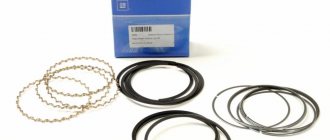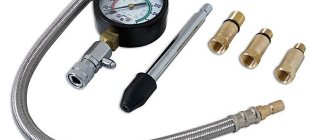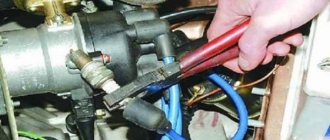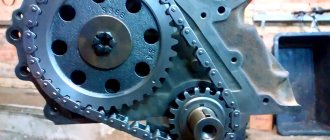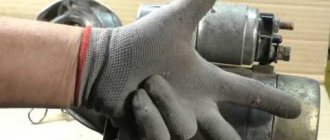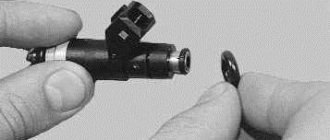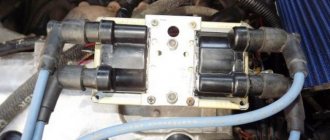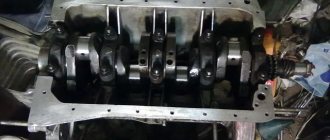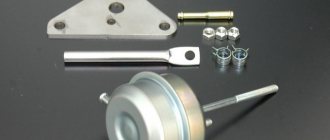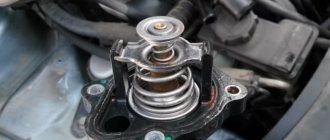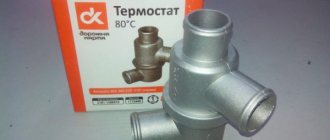Valve stem seals. Signs and causes of wear. Recommendations for selection - DRIVE2
Oil seals (oil seals)
prevent oil from entering the combustion chamber and allow for economical oil consumption.
Difference between valve stem seals and oil control rings.
Often inexperienced car owners ask how to determine what is on their car: rings or caps.
The answer is that both oil rings and caps are required for optimal engine performance. The rings remove residual oil from the moving piston and provide piston lubrication, and oil seals are installed on the valve stems. In fact, both spare parts perform the same function: protect the combustion chamber from oil. Oil getting into the combustion chamber of an internal combustion engine is fraught with the appearance of carbon deposits on the valve and on the cylinder walls of the gas distribution chamber. As a result, the engine will perform worse and fail faster. Among other things, oil getting into the combustion chamber worsens the quality of the gasoline-air mixture and clogs the grooves of the piston rings. Signs of wear on valve stem seals: 1.
Increased vehicle oil consumption.
Oil consumption can reach up to 1 liter of oil per 1000 km. 2.
The appearance of blue smoke from the exhaust pipe when starting the engine or when braking.
3.
The electrodes on the spark plugs are oily and greasy.
Reasons for wear: 1. Time.
Over time, valve stem seals inevitably lose their elasticity and allow more oil to pass through.
For domestic cars, after overcoming 20,000 kilometers, a mandatory replacement is recommended. 2. Working conditions.
The wear of the caps is due to their constant operation.
Every time (150 to 12,000 times per minute) the valve opens, the cap removes excess oil from it. 3. Chemical exposure.
The caps are made of rubber and are exposed to the aggressive chemical environment of combustion products and oil suspension.
Inevitably, over time, the rubber loses its elasticity and hardness and the valve stem seals fail. What you need to pay attention to when purchasing valve stem seals:
Of course, it is recommended to use only those caps that are designed for a specific engine, but this is not always possible or advisable. Firstly, new caps on an old motor can be very useful and will improve the fit; secondly, original caps may be expensive or unavailable and it makes sense to order analogues if replacement is needed here and now.
In order to select the right cap so that it does not come off and fits in size, you must follow the following selection rules:
1.
An analogue can only be 0.5 mm higher than the original.
Otherwise, the spring plate may damage the cap. 2.
The diameter of the cap cannot be too large and must pass freely through the valve spring.
Today, domestic manufacturers of caps are inferior to imported ones. We recommend the use of global manufacturers such as AE (Payen), Elring, Glazer, Goetze and Reinz others. To avoid purchasing low-quality or counterfeit products, purchase valve stem seals and other spare parts in our online store. We guarantee the correct selection of spare parts and will provide a replacement part or refund in case of defective or incorrect selection.
Cause of smoke in the exhaust pipe
In order to understand the question of why the engine smokes, you need to have an idea of what happens in it during operation.
A fuel mixture is formed in the combustion chamber, which is compressed by the piston and ignited by a spark from the spark plug. The mixture is supplied through the inlet valves, and the spent mixture is discharged through the outlet valves. The pistons have special oil intake rings; they are needed to collect excess oil on the cylinder walls so that it does not enter the combustion chamber.
The engine valves also have special seals (caps), which serve to ensure that the oil located in the cylinder head does not enter the combustion chamber. In addition, spark plugs also play an important role, and if they have a weak spark, or the gaps between the electrodes are incorrectly set, then the fuel mixture in the engine will not burn completely.
Based on this, we can identify the following causes of engine smoke.
- Spark plug . If the spark plugs are faulty, that is, they produce a weak spark, or the gaps between their electrodes are set incorrectly, then the fuel mixture does not burn completely and is discharged from the combustion chamber with blue smoke. In the most severe cases it may be black.
- Piston oil intake rings. As stated above, oil intake rings perform a function related to cleaning the cylinder walls of excess oil so that it does not enter the combustion chamber. They are subject to a powerful frictional force. If they wear out, the oil enters the combustion chamber and ignites along with the fuel mixture. In this case, black smoke appears. Similar functions are also performed by engine rings, which also remove excess oil from the surface of the cylinders and can wear out over time.
- Valve caps. These are seals that serve to prevent the oil in the cylinder head from entering the combustion chamber, and are made of dense rubber. When it wears out, the lubricant enters the combustion chamber and ignites. This produces white (or bluish) smoke.
The last two reasons for smokiness will be discussed below. If a car owner notices the appearance of blue or blue smoke, he needs to pay close attention to the operation of the power unit’s spark plugs and have them diagnosed or replaced.
You need to remember that sometimes the cause of smoke in the exhaust pipe can be bad gasoline. It may contain various additives or additives that will create black or other colored smoke. This problem usually disappears when refueling with other fuel.
Why does the engine smoke?
The color of the exhaust can roughly indicate engine malfunction. Of course, only service station technicians can make an accurate diagnosis. But you will determine the direction of searching for a breakdown yourself. The material was prepared by specialists from the website Skrutit-speedometr.ru. With us you can professionally wind the speedometer on your car without traces of intervention and with a guarantee. The gas exhaust system is designed for certain parameters of the fuel mixture and its combustion technology. If everything is in order with this, the exhaust is cleaned as usual, and it practically does not stink; at above-zero temperatures, the smoke is almost unnoticeable. When any of the environmental systems in modern engines fail, a whole bunch of harmful substances enter the atmosphere. The process is accompanied by a change in the color and smell of exhaust gases. Such systems and elements include: ❶ Exhaust gas recirculation (EGR) system. Its operation does not affect the color of the exhaust.
When broken, the smell will change slightly and the levels of nitric oxide and CO will increase.
❷ Catalysts. Most often they are not the cause of the change in exhaust color, but the “victim”. A breakdown of the catalytic converter results in a strong odor coming from the exhaust pipe. You may observe the following phenomena: ☛ Clear smoke similar to steam
(like from a kettle in the kitchen).
Actually, this is water vapor. They are partly formed during the combustion of fuel (school chemistry), partly they are carbon monoxide converted into steam (the merit of the catalyst). Smoke is noticeable in cold weather and a cold engine. Accompanied by water condensate (drops from the muffler). This type of exhaust is not a cause for concern. ☛ The engine started smoking black
.
If it is a diesel engine, look for a problem in the particulate filter. The gasoline engine has its own nuances. More precisely, there is only one reason - a rich mixture or the presence of fuel in the exhaust gases. Why is this happening? Perhaps the injector valves are not holding. Excess fuel enters the cylinders and burns out in the exhaust system. Important!
Such a malfunction will quickly damage the catalysts .
Poor compression (valves or compression rings) may also be to blame. As a result, the efficiency of the power plant decreases and the ECU enriches the mixture. Another possible reason is a clogged fine fuel filter. Again, the computer “sees” the problem and supplies more gasoline to the cylinders than necessary.
Black smoke can also occur if the air filter is clogged. The lack of oxygen enriches the mixture, and the fuel burns out again in the muffler. And finally, incorrect operation of sensors (for example, lambda probes). Receiving erroneous data, the ECU forms the incorrect composition of the fuel mixture. Indirect signs of all these malfunctions are carbon deposits on the spark plugs. ☛ Blue smoke with a pungent smell of burnt oil (like on old motorcycles in which a two-stroke engine ran on a mixture of gasoline and oil). The reason is the entry of lubricants into the combustion chamber through oil scraper rings or caps. Indirect signs are high oil consumption “waste”. ☛ If the engine smokes when starting
, and as it warms up, the exhaust returns to normal, the oil seals on the valve necks have hardened.
As the material heats up, it softens and the problem disappears. ☛ Constant blue smoke
occurs if the oil scraper rings are stuck or destroyed.
Oil enters the combustion chamber and its combustion products come out with bluish smoke. ☛ After replacing the rings
(including compression ones), blue smoke may emit until the elements of the piston group rub in. After running in, the symptoms disappear. This is a sign of more serious problems. The cause of white exhaust is coolant in the cylinders. The cylinder head gasket may be broken. Coolant gets into the crankcase and cylinders (hence the strong smell of antifreeze). Also, white smoke with a pungent odor comes out if there is a crack in the cooling jacket of the cylinder block. Not only is the coolant in the combustion chamber bad, but antifreeze also leaks. First of all, check the levels of technical fluids: oil and coolant.
By indirect signs you will determine the likely breakdown. Having assessed your capabilities (service station or your own garage), purchase consumables (gaskets, rings, caps, filters) and prepare the car for repair.
If a malfunction catches you on the highway, drive at low speeds to the repair site, periodically checking the oil and coolant levels.
What is the purpose of piston rings
To ensure that the presented spare parts last as long as possible, experts recommend following the following recommendations:
- Use sufficiently high-quality oils and replace basic technical fluids on time.
- Change the air filter promptly.
- Use only good fuel and replace your car's fuel filter on time.
- In winter, it takes a long time to warm up the engine.
- Do not overheat the engine.
- Repair worn cylinders in a timely manner.
- After replacement, allow the new rings to break in and do not overload the engine for 5,000 kilometers.
How to identify valve stem seals
You will need
- – a device for compressing valve springs;
- – tweezers or magnetized screwdriver;
- – a device for removing valve stem seals.
Instructions To check the condition of the oil seals, start the engine, let it idle for a while, then sharply press the accelerator pedal and see what kind of smoke comes out of the exhaust pipe. If it is blue or gray, the valve stem seals are not doing their job and need to be replaced. Second test option: on a warm engine, raise the speed to four thousand, then sharply release the gas. If blue smoke comes out, the valve stem seals need to be changed. Please note that in the case when blue smoke comes out in all operating modes, becomes thicker as the speed increases, and compression in the cylinders drops, worn piston rings are to blame.
When replacing valve stem seals, start by disconnecting the negative cable from the battery. Then remove the cylinder head cover and place the piston of the first cylinder at the TDC (top dead center) position of the compression stroke. The piston of the fourth cylinder will also be in the same position. This is necessary in order to eliminate the possibility of dropping the valves into the cylinders.
Evenly loosen the bolts securing the rocker arm axle of the valve drive, then remove them. Please note that they have different head shapes. When reassembling, the bolts will need to be reinstalled, so remember their location. Remove the valve drive shaft along with the rocker arms. Install a device for compressing the valve springs; to do this, screw the bolt securing the rocker arm axis into one of the holes in the cylinder head. Hook the spring compressor onto this bolt. Compress the valve spring. Using tweezers or a magnetized screwdriver, remove two crackers from the plate. Remove the spring compression device, then its plate and the spring itself. Using a special valve stem seal remover, remove the cap. You can also pull it out with pliers, but it is important not to turn it from side to side, but to pull it straight up. Install a new cap, lubricating its inner surface with engine oil. Using a mandrel, carefully press the cap into place. Reassemble all previously removed elements.
After this, replace the caps of the second valve and two valves of the fourth cylinder in the same way.
Next, install the pistons of the second and third cylinders at TDC and, according to the algorithm described above, replace the valve stem seals.
Why is oil intensively consumed?
Naturally, when lubricant consumption suddenly increases, say, to 1 l/1,000 km, and even blue smoke comes out of the exhaust, this is a signal of a violation of the oil scraper functions. There are several reasons for this:
- The oil scraper rings are stuck.
- The caps have become stiff.
- The valve guides are worn out.
Everything would be fine, but these parts are located in different engine modules. So, MSC is a part of the cylinder head, and the rings are a piston element located in the cylinder block. This means that changing everything together is costly, both in terms of time and financially. For example, replacing the caps on a BMW N46B20 according to the A to Z principle will cost 25,000 rubles, and removing the piston caps will cost at least 60,000 rubles. And this is without spare parts.
As a result, it would be nice to determine without disassembly which particular group of parts failed. Whether this is possible is the topic of the next paragraph.
The engine is smoking - is it the rings or the caps?
The appearance of colored smoke from a car's exhaust pipe can cause panic in an inexperienced driver. And indeed, with the exception of rare cases, such a symptom warns of a serious breakdown. An experienced car enthusiast will immediately limit the range of problems to wear of the caps or rings. But here you need to know a few nuances.
When should you not worry?
In fact, there is only one type of smoke, after seeing which you can relax and exhale. We are talking about the appearance of thick white smoke when the ignition is turned on when the car is not warmed up. While the engine is cooling after operation, the water vapor generated during operation is converted into condensate. In parallel with the engine warming up, the condensate begins to evaporate. Against the background of cold air, hot steam takes on a thick and bright white color, which can frighten a beginner. This is a natural process, so there is nothing to be afraid of.
When did the trouble come?
But if the smoke from the exhaust pipe bursts with a blue glow, this is already a sign of a serious problem. It means that oil begins to leak into the combustion chamber along with the fuel. Therefore, owners of used, old cars are more susceptible to this problem. There is no point in delaying in this situation - already expensive repairs can become even more expensive and global with each passing week. But first you need to do a diagnostic to correctly determine the area of repair.
Diagnostic methods
So, if your engine is smoking, how can you figure out whether the rings or caps are faulty? It is not necessary to resort to computer diagnostic methods. There are two simple tests to identify the source of the problem:
- Worn oil seals can be easily identified by watching the car in motion using the rear-view mirrors. Once you have gained speed, release the gas pedal, allowing the car to slow down naturally. Then, sharply press the gas while watching the rear of the car in the mirror. If, when you press the gas, blue or bluish-white smoke comes out of the pipe, then the culprit is the stiff valve caps, which have ceased to cope with their function. For the second method, you will need to wait for the engine to cool down. Then, in neutral gear, begin to gain engine speed. Blue smoke from the chimney = replacement of caps. The least painful option for the wallet.
- Failure of the rings can only be recognized when it is hot. As a rule, they show themselves when the load on the engine increases. For example, when driving uphill or suddenly accelerating when overtaking. If, when performing these actions, you are left with a persistent oily trace of black or bluish color, everything is very bad. In the best case, if the piston rings are faulty, you will need to add engine oil more often than usual. Then the rings can lie down and repairs of this kind are commensurate with a major overhaul of the engine. An indirect sign of ring wear is a weakening of engine power when the car begins to “go hard”.
In custody
Finally, many people forget about such a problem as low-quality fuel. Gasoline poured into a nameless gas station in the outskirts can turn your exhaust into all the colors of the rainbow, depending on the chemicals added to it.
Video analysis
Instrumental check
A few words need to be said about how the technical condition of the engine is checked using instruments. To do this, you need to have a device called a compression meter. It doesn’t make sense to purchase it just for checking the engine, but we can say with great confidence that someone in the garage cooperative will have it. We can also say with great confidence that checking with its help gives the correct answer about the condition of the motor.
The compression test should only be carried out with the engine warmed up to operating temperature. You need to remove the spark plugs from the cylinder head, put the car on the handbrake and the gear shift lever in neutral. Next, forcefully insert the head of the compression gauge into the spark plug socket. After this, independently or with the help of an assistant, crank the engine crankshaft for a few seconds with the starter. The device will show the compression in this cylinder.
If its value is low, it is recommended to check again, but before doing so, pour 20-30 grams of engine oil into the cylinder. An increase in the compression value after this will confirm the wear of the piston rings. Coking of the piston rings can also help reduce compression. You can fight this, but this is a topic for another article.
To avoid this problem for as long as possible, follow all operating recommendations given by the manufacturer. Why the engine smokes, how to understand whether it’s the caps or rings after reading this article should become clear. Therefore, you need to try to ensure that the engine runs for a long time with clean exhaust.
Many car enthusiasts and owners of used cars are faced with the problem of smoke when starting the power unit, or when reaching high speeds, and do not understand where it comes from. In some cases, the engine emits white smoke or black smoke. Of course, this is an indication that there are some problems with the caps or piston rings. Below we will talk about what to do when the engine smokes, how to understand the rings or caps that are causing the smoke in the engine.
The engine started smoking: caps or rings
Quite often you notice that increased smoke appears from the exhaust pipe of a car. Sometimes situations get to the point where the car is literally shrouded in clouds of thick smoke. It is quite obvious that for every car enthusiast, the appearance of excessive smoke indicates the emergence of certain problems with the internal combustion engine. Let us immediately note that not always, but often, increased smoke indicates serious problems with the engine. At the same time, it will not be difficult for experienced drivers to determine the cause by the color and composition of the exhaust. However, for beginners it is not always easy to understand why the engine smokes, as well as to determine the cause and identify the rings or caps. Let's figure it out.
White or black smoke appears from the exhaust pipe
Let's start with the main types of smoke to better understand the problem. So, white smoke from the exhaust pipe is quite normal for warming up a cold engine. Moreover, it is a mistake to believe that it is smoke. It's actually steam. Water in vapor form is a natural product of the engine. In an unheated exhaust system, this vapor partially condenses and becomes visible, and water usually appears at the end of the exhaust pipe. As the engine and exhaust system warm up, condensation decreases. The colder the environment, the denser the vapor produced. At temperatures below 10 ° C, steam is formed even on a well-warmed engine, and in frosty temperatures of minus 20 - 25 degrees it acquires a thick white color with a bluish tint. Air humidity also affects the color and saturation of steam. The larger it is, the thicker the steam. Note that if steam is visible in the warm season, it is quite possible that this is due to coolant getting into the cylinders. Its shade depends on the composition of the coolant, weather, lighting, and also on the amount of coolant in the combustion chamber. Sometimes it can take on a bluish tint, resembling “oily” smoke.
But, unlike oil smoke, which leaves a bluish mist in the air for a long time, steam quickly dissipates.
It is quite difficult for an inexperienced motorist to determine by appearance what is the source of the smoke. In this case, you can use a proven verification method. To do this, on a well-heated engine, it is necessary to briefly cover the cut of the exhaust pipe with a sheet of white paper, while the condensed steam in the form of drops of water, when it hits the paper, will gradually evaporate and will not leave obvious greasy marks. If this simple test confirms that it is steam rather than oil smoke coming out of the exhaust system, action must be taken to correct the problem that is allowing coolant to enter the cylinders. Most often, liquid can enter the cylinders through the head gasket due to insufficient traction (in winter, coolant leakage is often observed at the junction of the block and head), burnout, and less often as a result of the formation of microcracks in the head or cylinder block.
By opening the radiator cap or expansion tank, it is easy to detect the smell of exhaust gases and a film of oil on the surface of the coolant.
All problems associated with white smoke from the exhaust pipe require elimination of not only the direct causes, but also a mandatory check of systems that can affect their occurrence: thermostat, switch sensor, clutch or fan itself, condition of the radiator, its plugs, hoses or connections. If white smoke and accompanying defects are noticed, then the car cannot be operated, as the defects progress quickly.
- Let's move on. Black smoke from the exhaust pipe indicates an over-enrichment of the fuel-air mixture or a deterioration in fuel combustion conditions. Therefore, we are talking about malfunctions of the fuel supply system. Such smoke is usually clearly visible against a light background and represents soot particles - products of incomplete combustion of fuel.
Black smoke is accompanied by high fuel consumption, often poor starting, unstable engine operation, high toxicity of exhaust gases, and often loss of power due to a non-optimal composition of the air-fuel mixture. By the way, in carburetor engines, black smoke usually occurs due to overflow in the float chamber due to a defective needle valve or due to coking of the air jets. In gasoline engines with electronic fuel injection, over-enrichment of the mixture usually occurs due to malfunction and failure of sensors (oxygen, air flow, etc.), as well as leakage of injectors. In diesel engines, black smoke appears when there is a malfunction in the high-pressure pump, injectors, or when the injection timing is not optimal.
To carry out accelerated diagnostics, it is also necessary to examine the condition of the spark plugs. Black deposits indicate that there is a need to replace the spark plugs with new ones, and diagnostics and adjustment of the power unit systems may also be required.
Please note that it is the bluish smoke (gray) that is associated with the combustion of motor oil in the engine cylinders. There can be many reasons for this: Now let's take a closer look at the problem of damage to caps and rings. Let us note that smoking and the most common causes of oil consumption are caps and rings. The purpose of the caps is to retain oil while the valves are operating. Poor quality and malfunction of these elements lead to loss of tightness; lubricant constantly leaks and accumulates in the cylinders.
As soon as the driver starts a cold engine after the vehicle has been idle for a long time, the accumulated oil will burn along with the fuel in the chamber. As a result, blue or blue smoke comes out of the car's exhaust pipe in a cloud.
Wear and sticking of oil scraper rings leads to excess lubricant entering the engine cylinders and subsequent combustion of the lubricant. The use of the ring decarbonization method temporarily solves the problem, but in this case the rings lose their elasticity, and the occurrence may resume.
To avoid serious damage to the power unit, it is necessary to constantly monitor the color of the exhaust gases.
With little wear of engine elements, a short-term appearance of blue smoke is observed during cold operation. As the motor heats up, the parts expand, and as a result of an increase in their temperature, the gaps between the mating surfaces of the elements decrease. The entry of oil into the combustion chamber stops, and the smoking disappears.
Diagnostics of engine smoke in garage conditions
So, to understand why the engine smokes, and also when rings or caps are a problem, you can use primary diagnostic methods. By the way, it is quite possible to determine what causes the engine smoke on your own. To do this, you do not need to have special equipment; just a compression gauge will be enough. To understand the reasons for this problem, you need to study a little about the operating principle of the internal combustion engine and the processes inside the internal combustion engine. To ignite a flammable mixture, it must be compressed. Compression in the cylinders is provided by a piston on which piston rings are installed for sealing.
Friction occurs between the piston, rings and cylinder walls. To reduce wear of rubbing parts, engine oil is supplied to their working area (on the rubbing surfaces).
Wear of the oil scraper ring is the culprit for oil entering the combustion chamber. The second way engine oil can enter the combustion chamber is through the gap between the valve and the guide sleeve. In order to prevent oil from entering the fuel combustion chamber, the valve stem and guide bushing are sealed using oil seals (valve seals). When the material from which the valve seals are made loses its elasticity, oil enters the cylinder. But it also happens that both malfunctions coincide; engine oil penetrates the cylinder both through worn rings and through valve stem seals.
Methods for diagnosing rings and caps
- Monitoring the condition of the motor. Diagnostics is needed when a sharp decrease in the oil level without visible leaks is noticed. Plumes of smoke from the engine when you sharply press the gas pedal during acceleration are a sign of wear on the valve stem seals.
- The engine behaves somewhat differently when the piston rings wear out or become coked. In this case, blue smoke appears when the engine is running under load, when going uphill, when overtaking and when accelerating sharply. In the rearview mirror you can see a trail of smoke trailing behind the car.
- Loss of engine power, difficult starting and increased fuel consumption are indicators of piston ring wear. The condition of the spark plugs can also indicate problems with the rings. Unscrew the spark plugs and inspect them carefully. If the working area of the spark plug is black, this is a sure sign of wear on the piston rings.
Parting recommendations
If diagnostic results are unsatisfactory, experienced owners usually act by elimination. First, an attempt is made to decarbonize the oil scraper rings. If this is your first time encountering this concept, we recommend reading about what decarbonization is and why the engine needs it, as well as about the technology for decaburning piston rings using dimexide, as one of the inexpensive and effective means.
If an attempt to remove coke does not bring results, then work is planned on the cylinder head. If replacing the valve stem seals is unsuccessful, then a “overhaul” is performed.
Good afternoon .
Today I decided to check the oil level, looking at the dipstick I saw the level was at min. At 154 thousand. There was an oil change now 159 thousand mileage during this period a total of 1 liter of oil was added. I decided to go to the service station today during rush hour to check the compression. There were almost 15 on all cylinders. I wanted to consult with the motor mechanic about why the compression is so high and why it takes oil. As I understand it, either rings or caps? Well, if there is a lot of compression, I understand that these are not rings but caps?
Having removed the spark plugs, they said to immediately replace them, I say, and I haven’t driven 5 thousand on them before, too, when replacing them they were the same. Another person came up and said that your compression is high due to the fact that oil gets into the cylinder and most likely through the caps, and your spark plugs are in this condition.
Quite often you notice that increased smoke appears from the exhaust pipe of a car. Sometimes situations get to the point where the car is literally shrouded in clouds of thick smoke. It is quite obvious that for every car enthusiast, the appearance of excessive smoke indicates the emergence of certain problems with the internal combustion engine.
Let us immediately note that not always, but often, increased smoke indicates serious problems with the engine. At the same time, it will not be difficult for experienced drivers to determine the cause by the color and composition of the exhaust. However, for beginners it is not always easy to understand why the engine smokes, as well as to determine the cause and identify the rings or caps. Let's figure it out.
